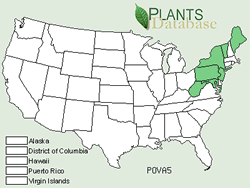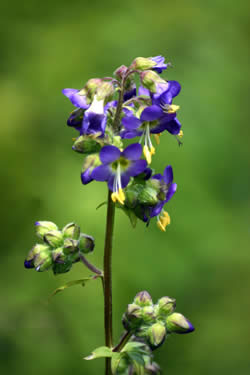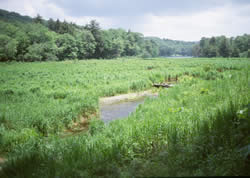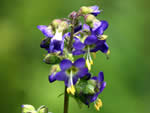USDA Forest Service Celebrating Wildflowers
|
|
|
Plant of the Week
Appalachian Jacob's ladder (Polemonium vanbruntiae)By MaryBeth Deller A member of the phlox family, Appalachian Jacob's ladder is a tall perennial wildflower with loose clusters of blue-violet bell-like flowers with protruding stamens. Leaves are alternate and divided into several pairs of leaflets. The “ladder” portion of its name refers to the well-separated, parallel, ladder-like arrangement of the leaflets in the leaf. That it is called Jacob's ladder alludes to the ladder to heaven seen by Jacob in a dream as told in the Old Testament. Its scientific name, Polemonium van-bruntiae, was first published by Nathaniel Lord Britton in the bulletin of the Torrey Botanical Club in 1892. He named the plant after Mrs. Cornelius Van Brunt, of Ulster County, New York, who supplied him with “…such fine and numerous specimens by means of which the marked differences between it and the European plant may be pointed out”. The European species, Polemonium caeruleum, is often cultivated in North America, sometimes escapes from cultivation, and can sometimes be confused with Polemonium van-bruntiae in the wild. Other common names by which this species is known include Van brunt's Polemonium, Jacob's ladder, and Eastern Jacob's ladder. Flowers open in mid- to late summer, with fruits developing in late summer to early fall. Stems in the wild are often browsed, possibly by deer or moose. As with many members of the phlox family, pollen is produced prior to when the stigma is receptive, which facilitates pollination between rather than within plants. Bees are known to pollinate this species, and many other insects, and even hummingbirds, have been observed visiting the showy flowers. Seeds are most likely dispersed by wind and water. While a number of medicinal uses have been described for two related species, Polemonium reptans and Polemonium caeruleum, Polemonium vanbruntiae appears to be appreciated primarily for its beauty. It grows in seepy areas, often where the soil pH is close to neutral. Its many habitats include seepy woods and stream banks, many kinds of wetlands, and even wet roadside ditches! Given this variety of places to grow, it may be surprising to learn that Appalachian Jacob's ladder is a narrow endemic known only from northeastern North America, where it occurs in Maine, Vermont, New York, Pennsylvania, Maryland, and West Virginia within the United States, and Quebec within Canada. Although some populations contain hundreds or thousands of plants, many are tiny, and they are often threatened by road maintenance, changes in water level due to human or beaver activity, grazing, and recreational activities, such as ATV use. They may also be threatened by succession from fairly open to more closed habitats. In New England, the center of Appalachian Jacob's ladder's distribution is on the Green Mountain National Forest in Vermont. On the National Forest, a researcher from the University of Vermont is studying various aspects of this species' reproductive biology, and National Forest staff members are studying its response to opening the canopy. The only other National Forest where it is known to occur is the Monongahela National Forest in West Virginia. For More Information: PLANTS Profile - Polemonium vanbruntiae, Appalachian Jacob's ladder |
|
| NOTE: PDF format links require the Adobe Acrobat Reader to view. | |
| top | Disclaimers | FOIA | Privacy Policy | Quality of Information | Photo Credits & Use |
Location: http://www.fs.fed.us/wildflowers/plant-of-the-week/polemonium_vanbruntiae.shtml
Last modified: Monday, 12-Jan-2009 13:16:21 EST




